Over time, after acquiring a bicycle, people begin to encounter problems transporting things, because a bicycle is also a transport. An invention that made traveling easier for millions - a bicycle rack. What happen, how to choose the right one and where to fix it? About this and much more in our article.
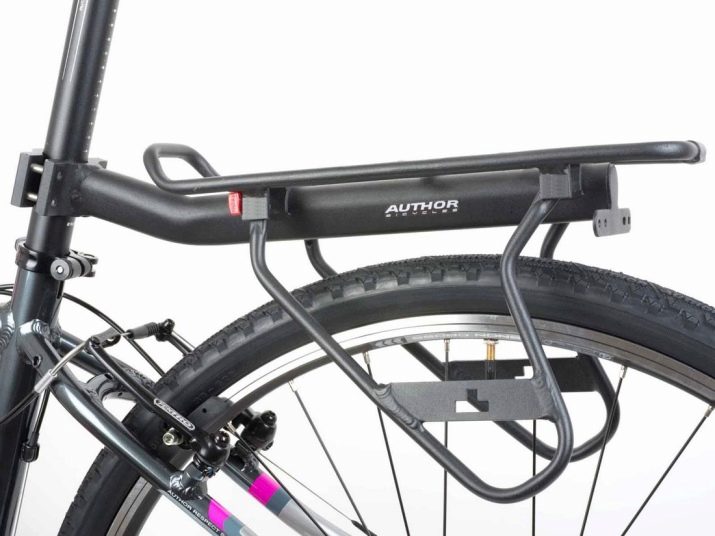
What is it and what is it for?
A bicycle rack is a metal device that allows you to place and carry cargo on a bicycle. Often people hang their bags on the steering wheel, which significantly complicates the control of the mechanism, but the bicycle carrier, installed correctly, does not upset the balance when riding. Such a thing is absolutely necessary in such cases as:
- while traveling around the city - Often ordinary backpacks may not be very comfortable, they can strain your back heavily;
- during the hike - it is possible to install a specialized “bag-pants”, which has a large capacity, but leave a lot of space from the trunk itself to secure the rest of the luggage;
- like a seat - for riding your friends and relatives;
- to set the basket - allows you to transport small pets or other things;
- for installing a child seat - makes it possible to transport small children more safely.
The bicycle rack allows you to transport a much larger number of heavy and bulky goods, when compared with similar transportation on the shoulders or on the steering wheel.
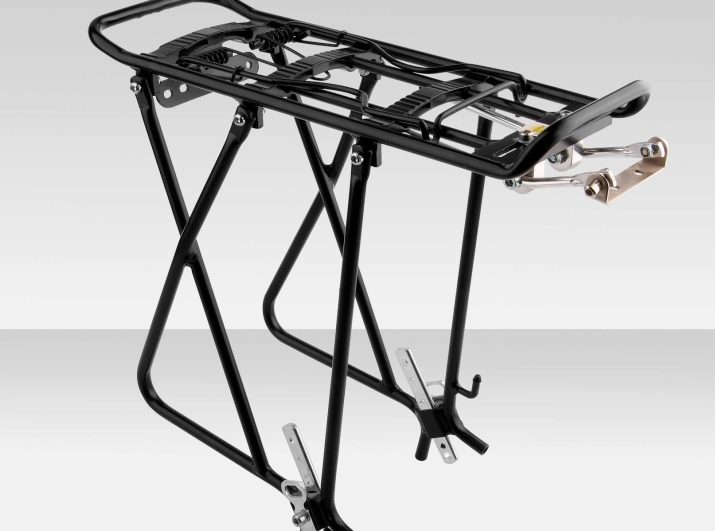
Advantages and disadvantages
The advantages of this device include the following:
- good for your health - reduction of load on the back, which previously carried heavy backpacks; sooner or later incorrect posture affects the body with pain in the hips, knees and ankle joints, and when using the bike carrier these effects can be leveled;
- conveniently - often with other types of transportation, bags can touch the wheels, get stuck in them, break or break the wheel, which can lead to an accident; the trunk avoids such situations;
- comfortable for the body - in the summer, under the backpacks, the back often sweats, which causes some discomfort, because at the destination it will have to be removed; there is a bicycle rack - no problem.
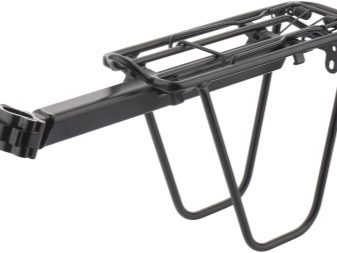
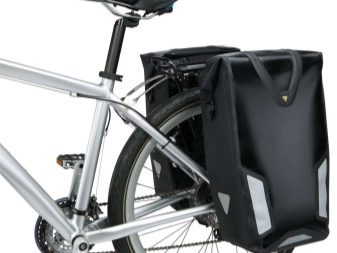
Of the disadvantages of this method of transportation, the following should be noted:
- weight gain - the bike carrier has a certain weight, depending on the type of metal of which the trunk is made;
- increased load on the back of the bike - when transporting extremely heavy loads, the rear wheel becomes more prone to deformation;
- the inability to fix the brackets to the frame - in some trim levels there are no holes for the trunk, but this drawback can be eliminated by choosing the console model.
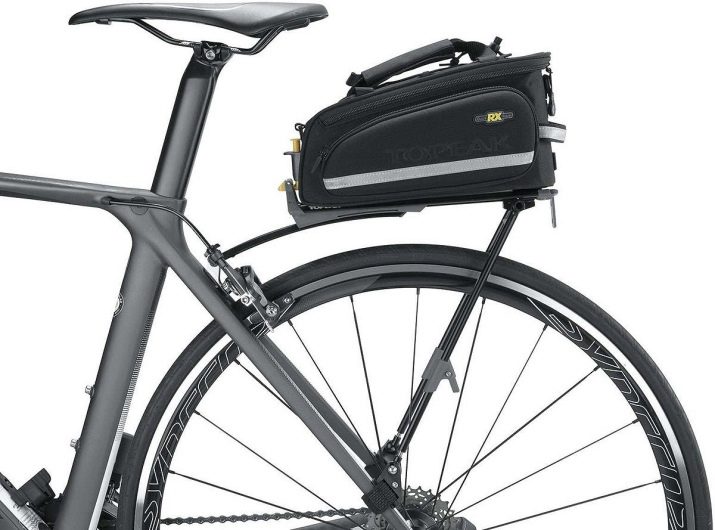
Types of structures and fasteners
When choosing a bicycle trunk, you should clarify and take into account such moments as:
- rim or disk type of brake system;
- the presence of grooves for fixing the device;
- it must be assumed what the degree of load on the structure can be, does it not exceed the maximum allowable for this type
- weight and reliability of the installed structure;
- spaciousness;
- reliability of securing cargo and trunk on a bicycle frame;
- the trunk is whole or it is possible to assemble and disassemble it;
- Check if the bike bag gets into the wheel.

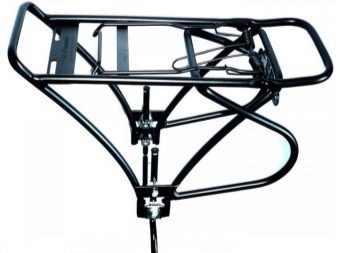
Bicycle racks are presented in several forms.
- Classic or rear trunk. This is a universal, most common, reliable and inexpensive type of bike carrier. Small bolts are used for attachment, which fix the device to the rear tube of the frame and to the feathers of the rear triangle of the frame. It is characterized by high stabilization during movement, which allows you to freely transport things and does not worry that they will fall into one of the sides. It is wonderful for a long trip in combination with the front or single, the installation of a child seat, for fixing a special backpack-bag (bag-pants). They can be all-welded and collapsible. The first are a frame structure and have great strength and reliability.
Collapsible is a set of several parts fastened with bolts, which can weaken over time, which leads to malfunctions or falling luggage.
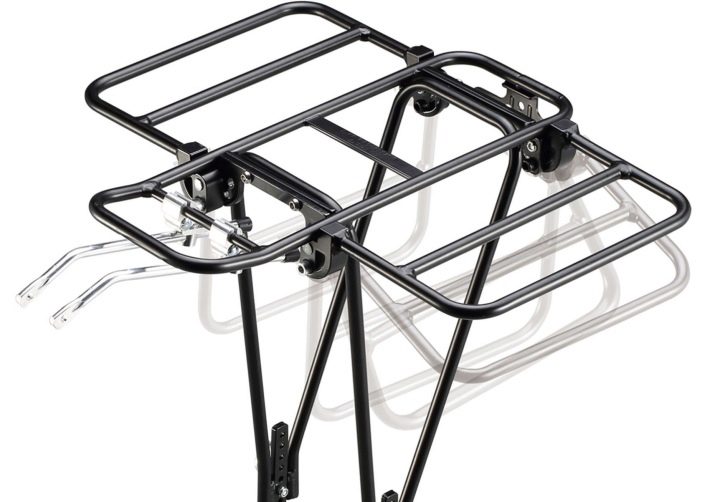
- Front trunk or basket. This model is used more often for walking around the city to transport small loads or pets. The usual front trunk can be used together with the rear for longer trips. It is mounted on the front tube of the bike. It is not recommended to load large objects, as they may overlap the view and make management difficult.
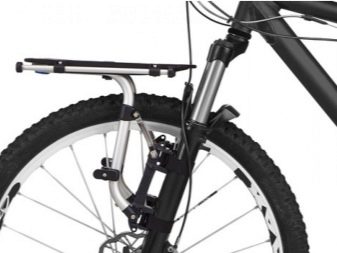
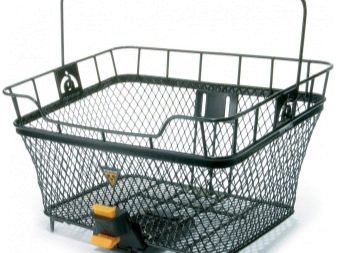
- Console or quick release trunk. The easiest to install view, since it is mounted only at one point (on the seat post) and does not have other support points. It is not suitable for transporting heavy loads, it does not have a protective pin to prevent contents from falling into the wheel spokes. Most often, such luggage racks are used for walking around the city or for short-term tourist trips. Disc braking complicates the installation of the structure on the bike.
The problem is that the trunk mounting racks interfere with the brake paths. This is solved by stopping the choice on the console model. Conventional roof racks under the disc braking system are fixed with rubber bands to the upper feathers of the frame.

The following varieties of designs:
- single column - most often steel, not very strong and stable, loosens during riding, therefore it is not suitable for long trips;
- double column - it can be steel or aluminum, the vertical stand serves as a support, and the other - to protect the load from the wheels;
- three-post - the safest and most comfortable, can be classic, V-shaped and Tranz-X.
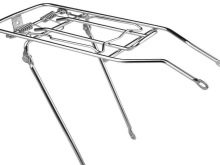
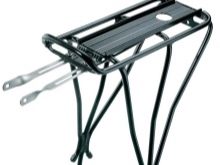
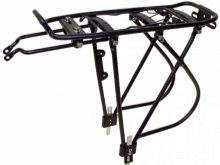
Permissible carrying capacity
For a classic bicycle rack, a load of 20-25 kg is provided, but this threshold should not be exceeded, otherwise the bolts and holes for the fasteners simply can not stand it. The front trunk can withstand loads of 5–7 kg. The basket can accommodate even more, but an increase in the load on the front of the bicycle entails a deterioration in its maneuverability, it becomes much more difficult to manage and for inexperienced users it can even lead to an accident.
They recommend distributing them between the front and rear trunks 1: 3 before a long trip with a lot of things.
For a quick-detachable trunk, the permissible weight of the transported cargo is up to 10-15 kg, but it must be taken into account that the entire load of things and the body weight of the seated person falls on the pipe under the saddle and the frame structure, so do not overload the bike carrier to the maximum figures.
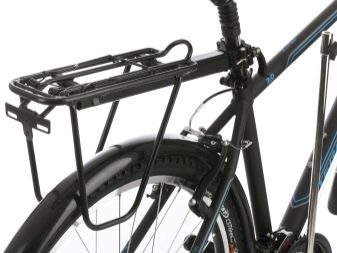

Materials of manufacture
In the manufacture of bicycle racks, metals such as aluminum, titanium and steel are used. An indisputable advantage in some kind of material is not.
Steel trunk:
- pros: very durable, low price, easy to repair using a welding machine, availability;
- minuses: weight (about 1 kg), susceptibility to corrosion.

Aluminum trunk:
- pros: light weight (500 g), average cost, versatility, not subject to corrosion;
- minuses: More expensive and more difficult to repair, compared to steel.
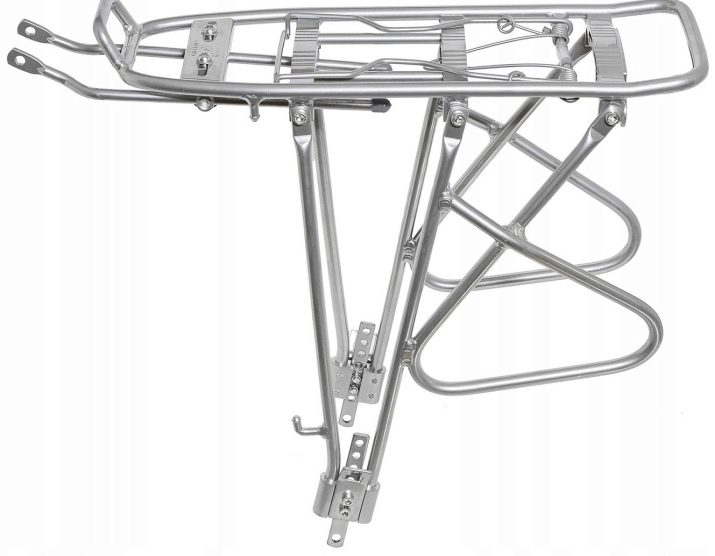
Titanium trunk:
- pros: light weight (500 g), strength, not prone to corrosion;
- minuses: more expensive than steel and aluminum, often not available for purchase at the store, poor maintainability.

The most common choice is a steel trunk. With a long trip, it is possible for a little money to eliminate its breakdown at the nearest service station.
Popular manufacturers
At the moment, companies such as Stels, Topeak and Ibera. Consider a brief overview of several models from these manufacturers.
Stels
Model Stels NH-CS515AA-X quickly removed, attached to the seatpost on a bicycle with a dual shock absorption system, suitable for wheels with a diameter of 24–28 inches, made of aluminum in black. Of the minuses, we can distinguish that the model is more expensive than similar designs.
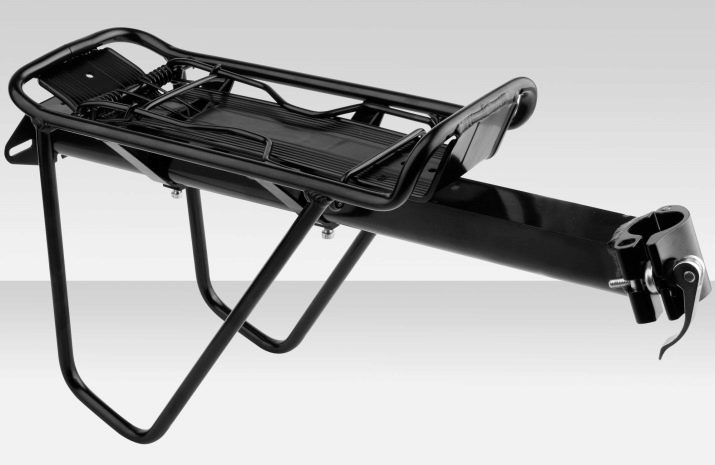
The Stels BLF-H18 / 010052 is a cheaper version of black and gray. It can be freely used on all types of bicycles with wheels of 20–28 inches. There are wheel flap pins, reflective plates.
Of the minuses, the greatest is the high probability of deformation.

Topeak
Model Topeak explorer tubular rack Designed specifically for bikes with 29 inch wheels. It is made of durable aluminum. There are fixing bolts for the rear flashlight of the middle weight category (640 g).
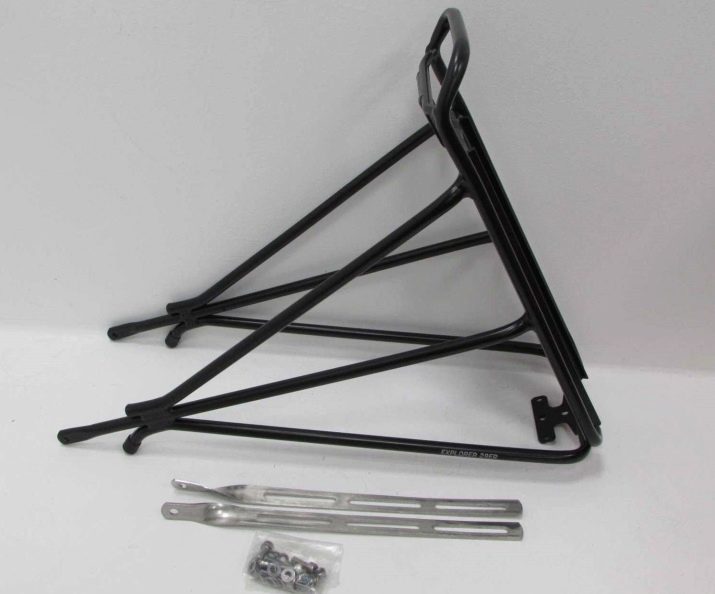
Model Topeak Explorer Tubular Disc Rack (TA2041-B) Designed for mountain bikes with 29 inch wheels. Installation on a disk system of brakes is possible. Production material - aluminum. Less - more expensive than all of the above analogues.
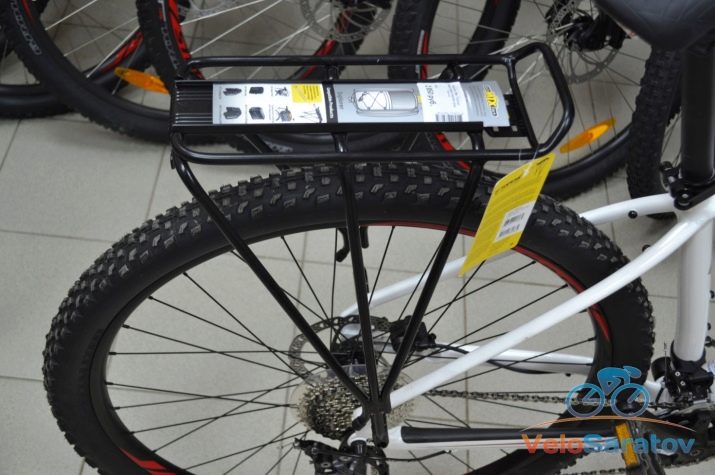
Ibera
Model Ibera IB-RA5 - Aluminum bicycle rack with disc braking system. It has three fixing points on the frame, suitable for 26–28 inch wheels, a little more than average weight (770 g), very reliable and durable.
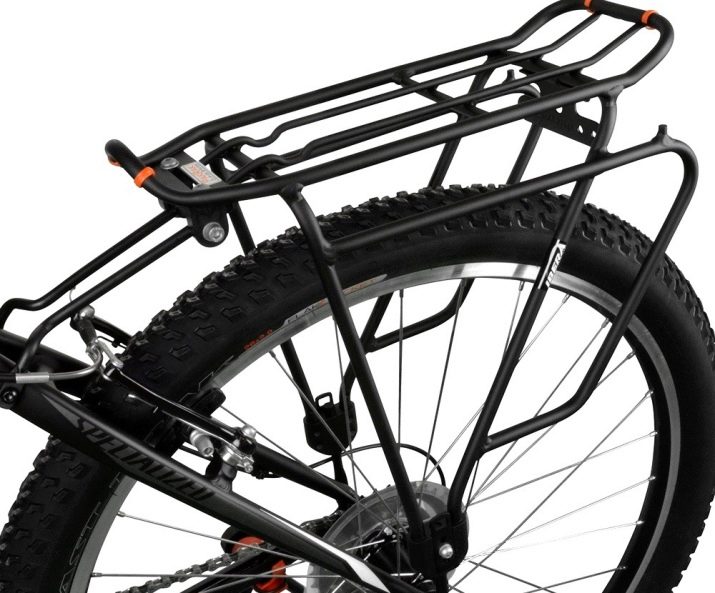
Model Ibera Pakrak Commuter IB-Ra11 designed to transport small items. It is attached to the seatpost, welded construction. The elastic bands for fixing the load are included. Of the minuses, it is worth noting rather weighty design - 880 g.


How to choose?
You should adhere to the following tips in order to better navigate your bike rack:
- durable and lightweight material;
- large surface area for luggage;
- raised front and rear parts of the platform so that the load does not move perpendicular to the axis;
- the presence of a clamp;
- the ability to adjust the height of the racks;
- the trunk has long fixation pins - “antennae” for fastening on the seatpost;
- trunk suitable for a wide range of wheel sizes (20, 22, 24, 26, 29 inches);
- a plate for a retro-reflector, a hook for a road pump;
- integral constructions do not break longer, and collapsible models can be compactly stored;
- the presence of a pin to protect against baggage falling into the wheel.


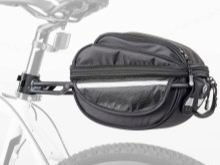
For a mountain bike, the feature is to increase capacity by attaching a makeshift holder and rim to the seatpost and feathers of the rear fork. Console bike bags or luggage carriers with 4 fixation points on the frame feathers are perfect for a sports bike. For touring bikes, choose a classic trunk with a spring-loaded bracket, optimally attached to bikes with 26-inch wheels.
The variety of bike racks can be confusing for an inexperienced bike owner, but, using the new knowledge from this article, you can safely go to the store and enjoy comfortable trips without thinking about where to put your things.
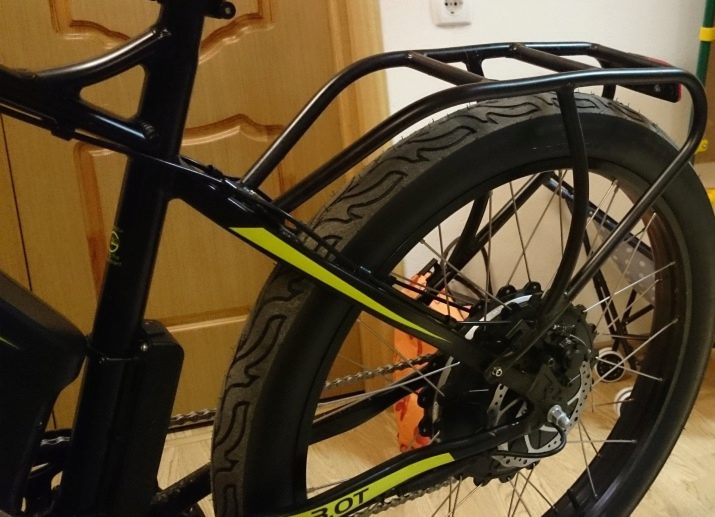
For tips on choosing a bicycle rack, see below.










